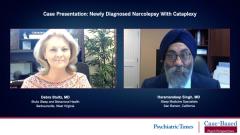
Case Presentation: Newly Diagnosed Narcolepsy With Cataplexy
In this custom video series, Haramandeep Singh, MD, and Debra Stultz, MD, discuss a case involving a 20-year-old woman newly diagnosed with narcolepsy and cataplexy, initial impressions, and appropriate provider referral.
Episodes in this series

Haramandeep Singh, MD: Welcome to this Psychiatric Times® Case-Based Psych Perspectives program titled “Narcolepsy Management and the Roles Neurologists and Psychiatrists Play.” I’m Dr Haramandeep Singh. I’m a board-certified psychiatrist and a sleep specialist, as well as the founder of Sleep Medicine Specialists of California in San Ramon. Joining me is Dr Debra Stultz. She’s a board-certified psychiatrist and sleep specialist, as well as the founder of Stultz Sleep and Behavioral Health in Barboursville, West Virginia.
The goal of our discussion is to share insights regarding the management of narcolepsy, as well as offer recommendations on how neurologists and psychiatrists can work with sleep specialists in the management of this disorder. Welcome, Dr Stultz.
Debra Stultz, MD: Thank you. It’s good to see you.
Haramandeep Singh, MD: It’s good to see you too. We’re going to start by reviewing a couple of case scenarios. I’ll describe the first case to you, and then we can discuss it.
Debra Stultz, MD: OK.
Haramandeep Singh, MD: This is a case of a 20-year-old woman who was referred for excessive daytime sleepiness and sleep attacks. Her excessive daytime sleepiness began in her later teens. She continued to have difficulty staying awake while she was in class and during exams, and then she recently got into a minor car accident due to a sleep attack. She then began experiencing sudden physical collapse when she got angry or when she laughed. Her knees would suddenly buckle. Then she underwent a medical evaluation and some testing, and narcolepsy with cataplexy was diagnosed. She was started on pitolisant, which reduced both her excessive daytime sleepiness and her cataplexy symptoms.
This is a scenario of a young adult who struggled with chronic daytime sleepiness and presents with pretty classic cataplexy, and then is eventually diagnosed with narcolepsy with cataplexy. We don’t often see that to be the case. But that’s what happened, and she started on pitolisant. What are your overall impressions on this case?
Debra Stultz, MD: There are some pretty typical findings for narcolepsy. The excessive daytime sleepiness started, and several years later the cataplexy started, which is very common. As you said, she had some pretty classic cataplexy symptoms, which isn’t always the case. But the strong emotions of laughter or anger and buckling of the knees are the common symptoms of narcolepsy that we would love to see on a day-to-day basis, but that’s not always the case.
Haramandeep Singh, MD: Absolutely. I appreciate you saying that because this is a case that we’d love to have step in our office. Like, “You’ve got narcolepsy and we know it,” right? But the general doctor out there who evaluates this patient may be questioning what’s going on with this patient and may have some other ideas. At this point, generally speaking, who would a general doctor refer this patient to: a sleep specialist, a psychiatrist, a neurologist?
Debra Stultz, MD: It would be wonderful if they referred them to a sleep specialist. Typically, these symptoms will help them know that this is a sleep disorder and that you need to go to a sleep specialist. But not all sleep specialists are even comfortable with narcolepsy. A lot of sleep laboratories primarily treat obstructive sleep apnea and pulmonary issues, so you need to make sure you have a sleep specialist who’s comfortable talking about narcolepsy and looking at the other things. A sleep specialist would be a great place to refer the patient to, but someone who specializes in sleep in psychiatry or neurology would also be a wonderful place to refer the patients to. Regardless, somebody is going to need to order a sleep study.
To look at the symptoms and make sure you’re evaluating both the sleepiness and the cataplexy, you need someone who’s comfortable with sleep disorders in general, and the patient to describe all the symptoms to whoever the provider is going to be. For instance, if they show up to a pulmonologist and say, “I’m sleepy,” but don’t give the other history about cataplexy, then they may be going down the path of looking at obstructive sleep apnea. If they go to a psychiatrist and talk about the sleepiness, and then they say, “Do you have insomnia? That must be depression,” then they could go off in another direction for depression. It’s the same thing with neurology. If they just focus on the cataplexy, we might get lost. We’ve got to make sure to tell our patients that if primary care or a psychiatry practice doesn’t do a lot of sleep medicine, to make sure the patients present both of their symptoms so they can clearly get diagnosed and treated.
Haramandeep Singh, MD: Those are some great points. I appreciate you bringing those up, because when the evaluating doctor sees this patient, who they refer them to is going to make a huge impact in their outcome. It would be great if doctors can recognize sleepiness and say, “This is a patient who should have a sleep evaluation before anything else,” because then we can target them in the right direction and get them on the right treatment. It makes a huge difference, so I appreciate your comments on that.
Transcript edited for clarity.
Disclosures:
Dr Stultz has disclosed that she serves as a consultant on the advisory board for Harmony Biosciences and that she receives support in her role with the speaker’s bureau for Harmony Biosciences and Jazz Pharmaceuticals.
Dr Singh has disclosed that he serves as a consultant and receives support in his role with the speaker's bureau for Jazz Pharmaceuticals and Harmony Biosciences.
Newsletter
Receive trusted psychiatric news, expert analysis, and clinical insights — subscribe today to support your practice and your patients.














